Comprehensive Analysis of IoT in Smart Cities: Annotated Bibliography
VerifiedAdded on 2023/04/19
|18
|4902
|410
Report
AI Summary
This report provides an annotated bibliography exploring the application of the Internet of Things (IoT) in smart cities. The bibliography includes summaries of several research papers, each focusing on different aspects of IoT implementation and its impact on urban environments. The papers cover a range of topics, including the use of IoT for sustainable smart city applications such as heat and electricity management and eco-conscious public transportation, as well as the use of IoT to incentivize shifts in mobility behavior. Other papers discuss the development of smart city frameworks, the challenges of IoT implementation, and the potential for using IoT to improve various urban services. The report also highlights the integration of cloud computing, the role of sensor networks, and the use of smart devices in creating efficient and interconnected city infrastructures. The annotated bibliography offers insights into the current state of IoT research and its practical applications in the development of smart cities.
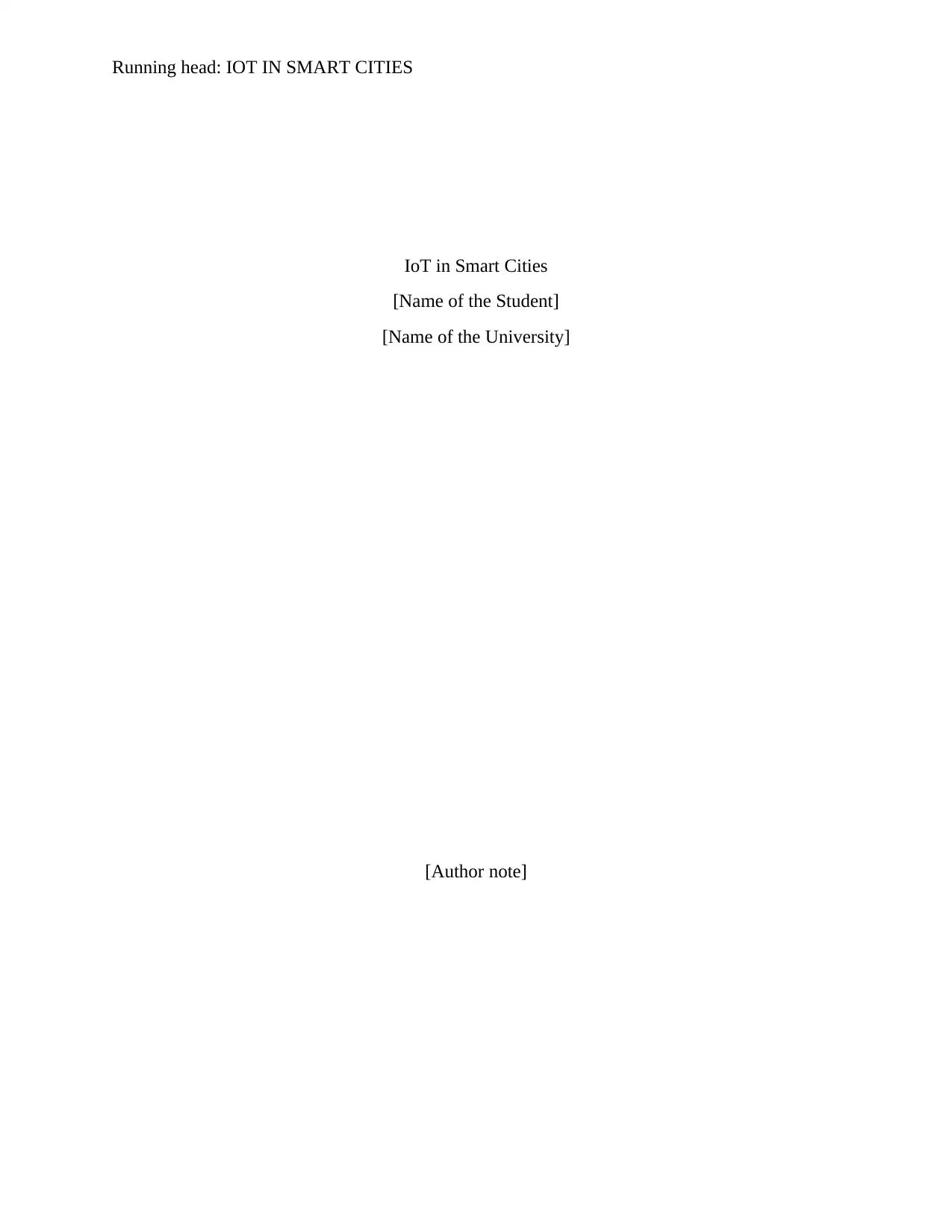
Running head: IOT IN SMART CITIES
IoT in Smart Cities
[Name of the Student]
[Name of the University]
[Author note]
IoT in Smart Cities
[Name of the Student]
[Name of the University]
[Author note]
Paraphrase This Document
Need a fresh take? Get an instant paraphrase of this document with our AI Paraphraser
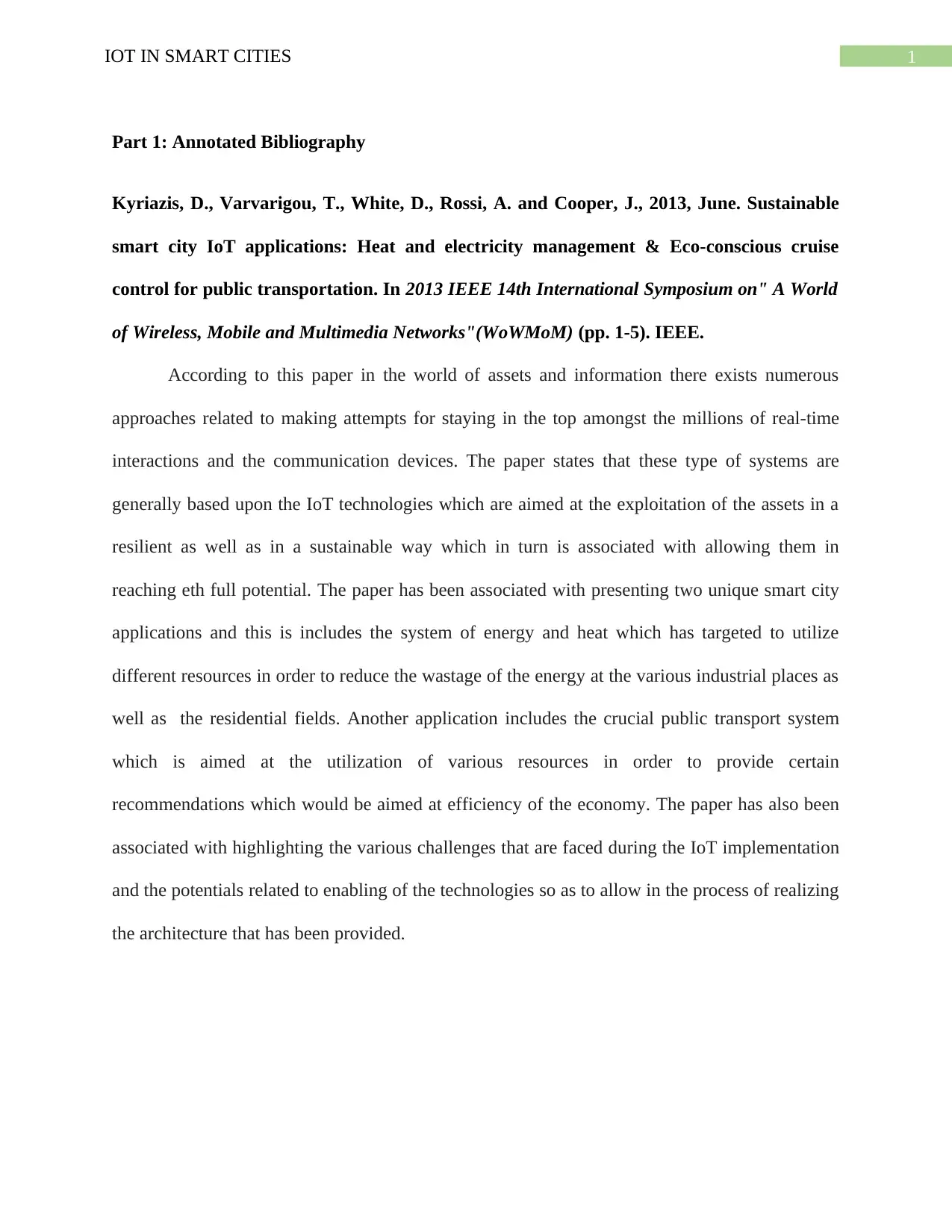
1IOT IN SMART CITIES
Part 1: Annotated Bibliography
Kyriazis, D., Varvarigou, T., White, D., Rossi, A. and Cooper, J., 2013, June. Sustainable
smart city IoT applications: Heat and electricity management & Eco-conscious cruise
control for public transportation. In 2013 IEEE 14th International Symposium on" A World
of Wireless, Mobile and Multimedia Networks"(WoWMoM) (pp. 1-5). IEEE.
According to this paper in the world of assets and information there exists numerous
approaches related to making attempts for staying in the top amongst the millions of real-time
interactions and the communication devices. The paper states that these type of systems are
generally based upon the IoT technologies which are aimed at the exploitation of the assets in a
resilient as well as in a sustainable way which in turn is associated with allowing them in
reaching eth full potential. The paper has been associated with presenting two unique smart city
applications and this is includes the system of energy and heat which has targeted to utilize
different resources in order to reduce the wastage of the energy at the various industrial places as
well as the residential fields. Another application includes the crucial public transport system
which is aimed at the utilization of various resources in order to provide certain
recommendations which would be aimed at efficiency of the economy. The paper has also been
associated with highlighting the various challenges that are faced during the IoT implementation
and the potentials related to enabling of the technologies so as to allow in the process of realizing
the architecture that has been provided.
Part 1: Annotated Bibliography
Kyriazis, D., Varvarigou, T., White, D., Rossi, A. and Cooper, J., 2013, June. Sustainable
smart city IoT applications: Heat and electricity management & Eco-conscious cruise
control for public transportation. In 2013 IEEE 14th International Symposium on" A World
of Wireless, Mobile and Multimedia Networks"(WoWMoM) (pp. 1-5). IEEE.
According to this paper in the world of assets and information there exists numerous
approaches related to making attempts for staying in the top amongst the millions of real-time
interactions and the communication devices. The paper states that these type of systems are
generally based upon the IoT technologies which are aimed at the exploitation of the assets in a
resilient as well as in a sustainable way which in turn is associated with allowing them in
reaching eth full potential. The paper has been associated with presenting two unique smart city
applications and this is includes the system of energy and heat which has targeted to utilize
different resources in order to reduce the wastage of the energy at the various industrial places as
well as the residential fields. Another application includes the crucial public transport system
which is aimed at the utilization of various resources in order to provide certain
recommendations which would be aimed at efficiency of the economy. The paper has also been
associated with highlighting the various challenges that are faced during the IoT implementation
and the potentials related to enabling of the technologies so as to allow in the process of realizing
the architecture that has been provided.

2IOT IN SMART CITIES
Poslad, S., Ma, A., Wang, Z. and Mei, H., 2015. Using a smart city IoT to incentivise and
target shifts in mobility behaviour—Is it a piece of pie?. Sensors, 15(6), pp.13069-13096.
According to this paper the increased population in the urban regions has been associated
with demanding an adequate provision related to the services and the infrastructure for the
purpose of meeting the requirements that the inhabitants of a city is having. For this reason there
is a need of maximum utilization of various communication and information technologies for the
purpose of achieving the objectives. This in turn is associated with presenting on itself is a scope
related to the implementation of the smart cities and this is the place where the city management
along with the populations seem to be alike and are provided with the access to the various real-
time data related to the environment of urban area. This information will act as the fundamental
aspect for yje decisions, future planning and the required action. The article also explained a
holistic structure which helps in realizing of the smart cities by implementation of the IoT
technology. The framework is also associated with providing solution which are all-
encompassing for having a sensory level comprehensive information system for urban areas as
well as from the networking supporting structure all throughout the information management
process as well as the implementation of the cyber-physical techniques based on cloud, which
are already existing. The main vision of this paper includes the analysis of the smart city using
IoT technology for noise mapping case study which in turn is associated with illustration of a
new method that is to be used by all the existing operations which can be adopted for the purpose
of enhancing the services inside a city.
Poslad, S., Ma, A., Wang, Z. and Mei, H., 2015. Using a smart city IoT to incentivise and
target shifts in mobility behaviour—Is it a piece of pie?. Sensors, 15(6), pp.13069-13096.
According to this paper the increased population in the urban regions has been associated
with demanding an adequate provision related to the services and the infrastructure for the
purpose of meeting the requirements that the inhabitants of a city is having. For this reason there
is a need of maximum utilization of various communication and information technologies for the
purpose of achieving the objectives. This in turn is associated with presenting on itself is a scope
related to the implementation of the smart cities and this is the place where the city management
along with the populations seem to be alike and are provided with the access to the various real-
time data related to the environment of urban area. This information will act as the fundamental
aspect for yje decisions, future planning and the required action. The article also explained a
holistic structure which helps in realizing of the smart cities by implementation of the IoT
technology. The framework is also associated with providing solution which are all-
encompassing for having a sensory level comprehensive information system for urban areas as
well as from the networking supporting structure all throughout the information management
process as well as the implementation of the cyber-physical techniques based on cloud, which
are already existing. The main vision of this paper includes the analysis of the smart city using
IoT technology for noise mapping case study which in turn is associated with illustration of a
new method that is to be used by all the existing operations which can be adopted for the purpose
of enhancing the services inside a city.
⊘ This is a preview!⊘
Do you want full access?
Subscribe today to unlock all pages.

Trusted by 1+ million students worldwide
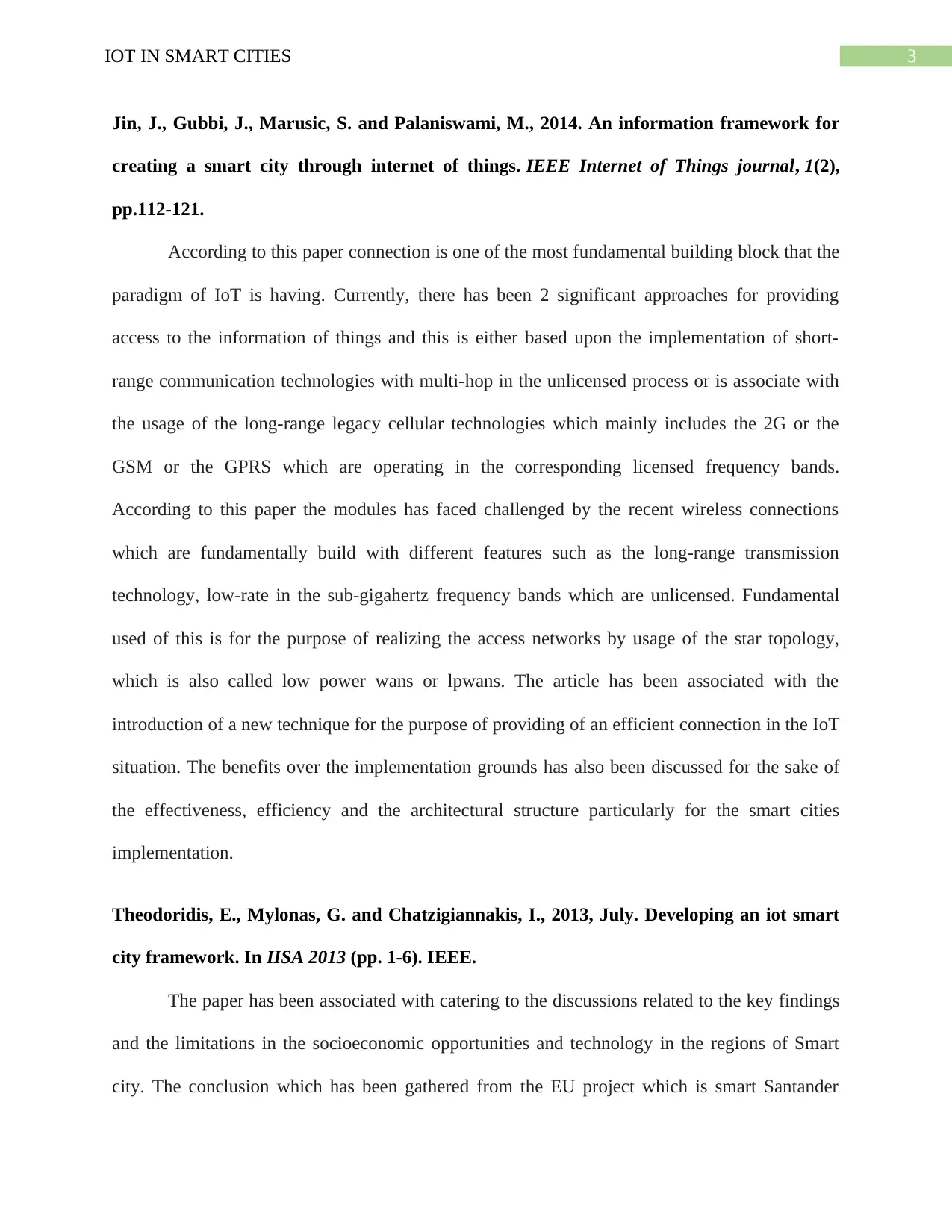
3IOT IN SMART CITIES
Jin, J., Gubbi, J., Marusic, S. and Palaniswami, M., 2014. An information framework for
creating a smart city through internet of things. IEEE Internet of Things journal, 1(2),
pp.112-121.
According to this paper connection is one of the most fundamental building block that the
paradigm of IoT is having. Currently, there has been 2 significant approaches for providing
access to the information of things and this is either based upon the implementation of short-
range communication technologies with multi-hop in the unlicensed process or is associate with
the usage of the long-range legacy cellular technologies which mainly includes the 2G or the
GSM or the GPRS which are operating in the corresponding licensed frequency bands.
According to this paper the modules has faced challenged by the recent wireless connections
which are fundamentally build with different features such as the long-range transmission
technology, low-rate in the sub-gigahertz frequency bands which are unlicensed. Fundamental
used of this is for the purpose of realizing the access networks by usage of the star topology,
which is also called low power wans or lpwans. The article has been associated with the
introduction of a new technique for the purpose of providing of an efficient connection in the IoT
situation. The benefits over the implementation grounds has also been discussed for the sake of
the effectiveness, efficiency and the architectural structure particularly for the smart cities
implementation.
Theodoridis, E., Mylonas, G. and Chatzigiannakis, I., 2013, July. Developing an iot smart
city framework. In IISA 2013 (pp. 1-6). IEEE.
The paper has been associated with catering to the discussions related to the key findings
and the limitations in the socioeconomic opportunities and technology in the regions of Smart
city. The conclusion which has been gathered from the EU project which is smart Santander
Jin, J., Gubbi, J., Marusic, S. and Palaniswami, M., 2014. An information framework for
creating a smart city through internet of things. IEEE Internet of Things journal, 1(2),
pp.112-121.
According to this paper connection is one of the most fundamental building block that the
paradigm of IoT is having. Currently, there has been 2 significant approaches for providing
access to the information of things and this is either based upon the implementation of short-
range communication technologies with multi-hop in the unlicensed process or is associate with
the usage of the long-range legacy cellular technologies which mainly includes the 2G or the
GSM or the GPRS which are operating in the corresponding licensed frequency bands.
According to this paper the modules has faced challenged by the recent wireless connections
which are fundamentally build with different features such as the long-range transmission
technology, low-rate in the sub-gigahertz frequency bands which are unlicensed. Fundamental
used of this is for the purpose of realizing the access networks by usage of the star topology,
which is also called low power wans or lpwans. The article has been associated with the
introduction of a new technique for the purpose of providing of an efficient connection in the IoT
situation. The benefits over the implementation grounds has also been discussed for the sake of
the effectiveness, efficiency and the architectural structure particularly for the smart cities
implementation.
Theodoridis, E., Mylonas, G. and Chatzigiannakis, I., 2013, July. Developing an iot smart
city framework. In IISA 2013 (pp. 1-6). IEEE.
The paper has been associated with catering to the discussions related to the key findings
and the limitations in the socioeconomic opportunities and technology in the regions of Smart
city. The conclusion which has been gathered from the EU project which is smart Santander
Paraphrase This Document
Need a fresh take? Get an instant paraphrase of this document with our AI Paraphraser
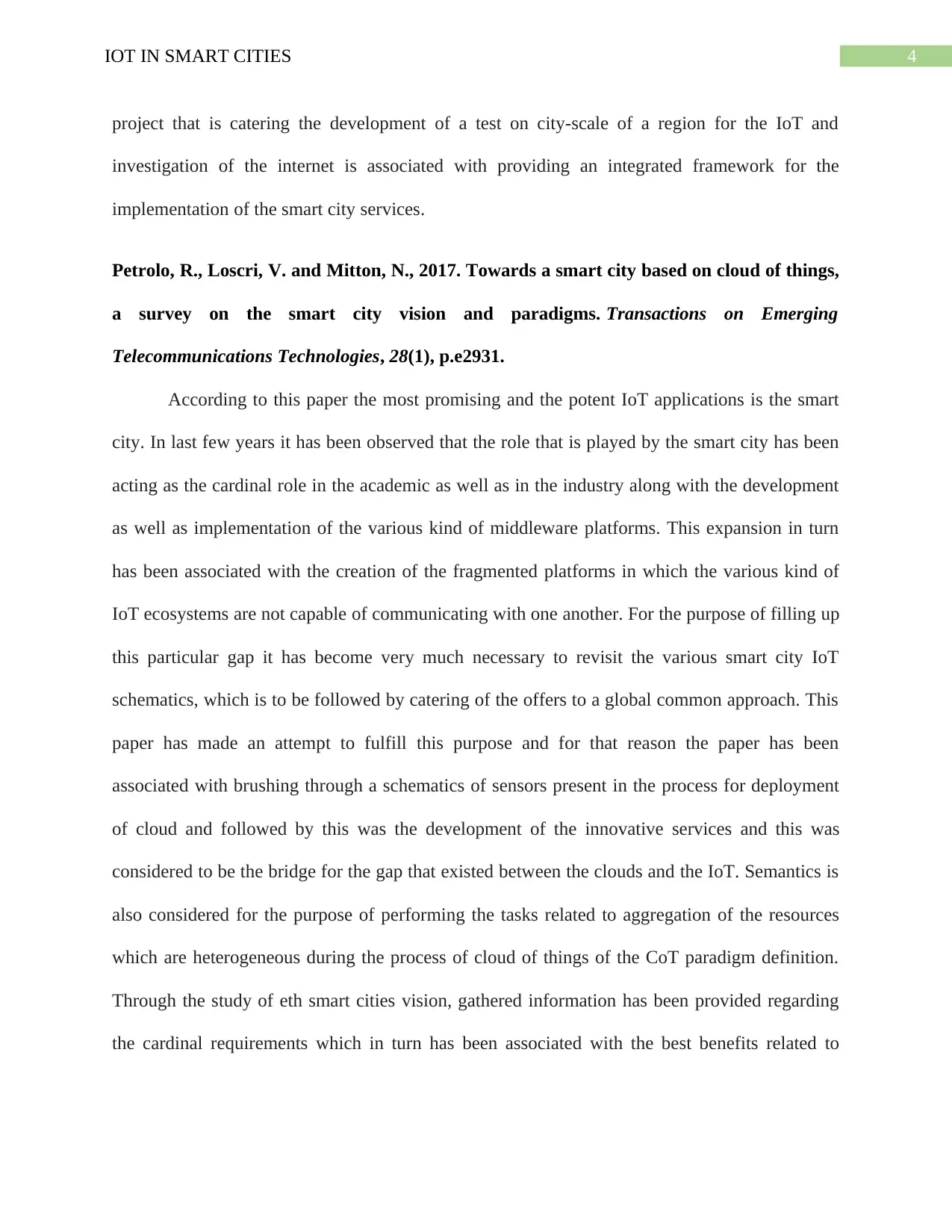
4IOT IN SMART CITIES
project that is catering the development of a test on city-scale of a region for the IoT and
investigation of the internet is associated with providing an integrated framework for the
implementation of the smart city services.
Petrolo, R., Loscri, V. and Mitton, N., 2017. Towards a smart city based on cloud of things,
a survey on the smart city vision and paradigms. Transactions on Emerging
Telecommunications Technologies, 28(1), p.e2931.
According to this paper the most promising and the potent IoT applications is the smart
city. In last few years it has been observed that the role that is played by the smart city has been
acting as the cardinal role in the academic as well as in the industry along with the development
as well as implementation of the various kind of middleware platforms. This expansion in turn
has been associated with the creation of the fragmented platforms in which the various kind of
IoT ecosystems are not capable of communicating with one another. For the purpose of filling up
this particular gap it has become very much necessary to revisit the various smart city IoT
schematics, which is to be followed by catering of the offers to a global common approach. This
paper has made an attempt to fulfill this purpose and for that reason the paper has been
associated with brushing through a schematics of sensors present in the process for deployment
of cloud and followed by this was the development of the innovative services and this was
considered to be the bridge for the gap that existed between the clouds and the IoT. Semantics is
also considered for the purpose of performing the tasks related to aggregation of the resources
which are heterogeneous during the process of cloud of things of the CoT paradigm definition.
Through the study of eth smart cities vision, gathered information has been provided regarding
the cardinal requirements which in turn has been associated with the best benefits related to
project that is catering the development of a test on city-scale of a region for the IoT and
investigation of the internet is associated with providing an integrated framework for the
implementation of the smart city services.
Petrolo, R., Loscri, V. and Mitton, N., 2017. Towards a smart city based on cloud of things,
a survey on the smart city vision and paradigms. Transactions on Emerging
Telecommunications Technologies, 28(1), p.e2931.
According to this paper the most promising and the potent IoT applications is the smart
city. In last few years it has been observed that the role that is played by the smart city has been
acting as the cardinal role in the academic as well as in the industry along with the development
as well as implementation of the various kind of middleware platforms. This expansion in turn
has been associated with the creation of the fragmented platforms in which the various kind of
IoT ecosystems are not capable of communicating with one another. For the purpose of filling up
this particular gap it has become very much necessary to revisit the various smart city IoT
schematics, which is to be followed by catering of the offers to a global common approach. This
paper has made an attempt to fulfill this purpose and for that reason the paper has been
associated with brushing through a schematics of sensors present in the process for deployment
of cloud and followed by this was the development of the innovative services and this was
considered to be the bridge for the gap that existed between the clouds and the IoT. Semantics is
also considered for the purpose of performing the tasks related to aggregation of the resources
which are heterogeneous during the process of cloud of things of the CoT paradigm definition.
Through the study of eth smart cities vision, gathered information has been provided regarding
the cardinal requirements which in turn has been associated with the best benefits related to
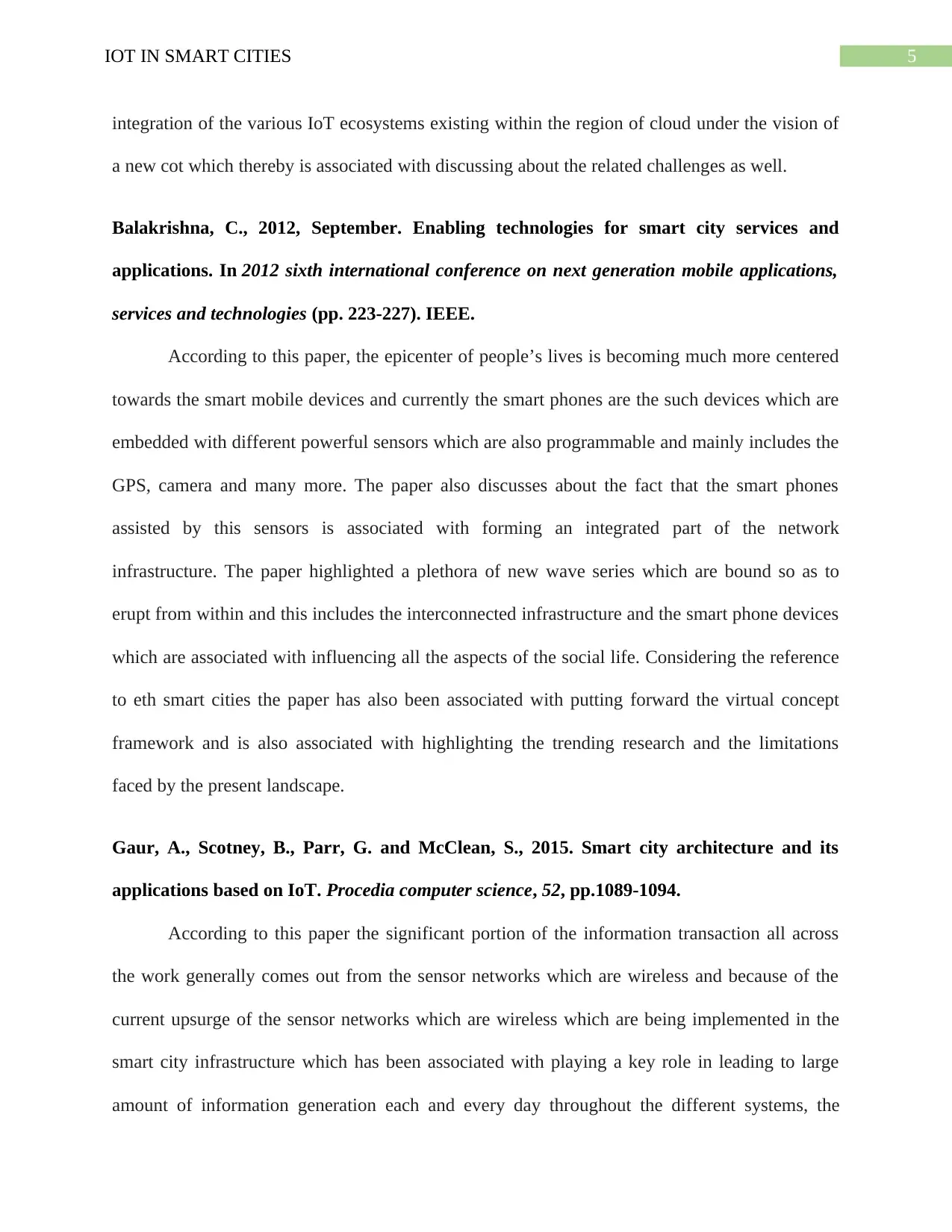
5IOT IN SMART CITIES
integration of the various IoT ecosystems existing within the region of cloud under the vision of
a new cot which thereby is associated with discussing about the related challenges as well.
Balakrishna, C., 2012, September. Enabling technologies for smart city services and
applications. In 2012 sixth international conference on next generation mobile applications,
services and technologies (pp. 223-227). IEEE.
According to this paper, the epicenter of people’s lives is becoming much more centered
towards the smart mobile devices and currently the smart phones are the such devices which are
embedded with different powerful sensors which are also programmable and mainly includes the
GPS, camera and many more. The paper also discusses about the fact that the smart phones
assisted by this sensors is associated with forming an integrated part of the network
infrastructure. The paper highlighted a plethora of new wave series which are bound so as to
erupt from within and this includes the interconnected infrastructure and the smart phone devices
which are associated with influencing all the aspects of the social life. Considering the reference
to eth smart cities the paper has also been associated with putting forward the virtual concept
framework and is also associated with highlighting the trending research and the limitations
faced by the present landscape.
Gaur, A., Scotney, B., Parr, G. and McClean, S., 2015. Smart city architecture and its
applications based on IoT. Procedia computer science, 52, pp.1089-1094.
According to this paper the significant portion of the information transaction all across
the work generally comes out from the sensor networks which are wireless and because of the
current upsurge of the sensor networks which are wireless which are being implemented in the
smart city infrastructure which has been associated with playing a key role in leading to large
amount of information generation each and every day throughout the different systems, the
integration of the various IoT ecosystems existing within the region of cloud under the vision of
a new cot which thereby is associated with discussing about the related challenges as well.
Balakrishna, C., 2012, September. Enabling technologies for smart city services and
applications. In 2012 sixth international conference on next generation mobile applications,
services and technologies (pp. 223-227). IEEE.
According to this paper, the epicenter of people’s lives is becoming much more centered
towards the smart mobile devices and currently the smart phones are the such devices which are
embedded with different powerful sensors which are also programmable and mainly includes the
GPS, camera and many more. The paper also discusses about the fact that the smart phones
assisted by this sensors is associated with forming an integrated part of the network
infrastructure. The paper highlighted a plethora of new wave series which are bound so as to
erupt from within and this includes the interconnected infrastructure and the smart phone devices
which are associated with influencing all the aspects of the social life. Considering the reference
to eth smart cities the paper has also been associated with putting forward the virtual concept
framework and is also associated with highlighting the trending research and the limitations
faced by the present landscape.
Gaur, A., Scotney, B., Parr, G. and McClean, S., 2015. Smart city architecture and its
applications based on IoT. Procedia computer science, 52, pp.1089-1094.
According to this paper the significant portion of the information transaction all across
the work generally comes out from the sensor networks which are wireless and because of the
current upsurge of the sensor networks which are wireless which are being implemented in the
smart city infrastructure which has been associated with playing a key role in leading to large
amount of information generation each and every day throughout the different systems, the
⊘ This is a preview!⊘
Do you want full access?
Subscribe today to unlock all pages.

Trusted by 1+ million students worldwide
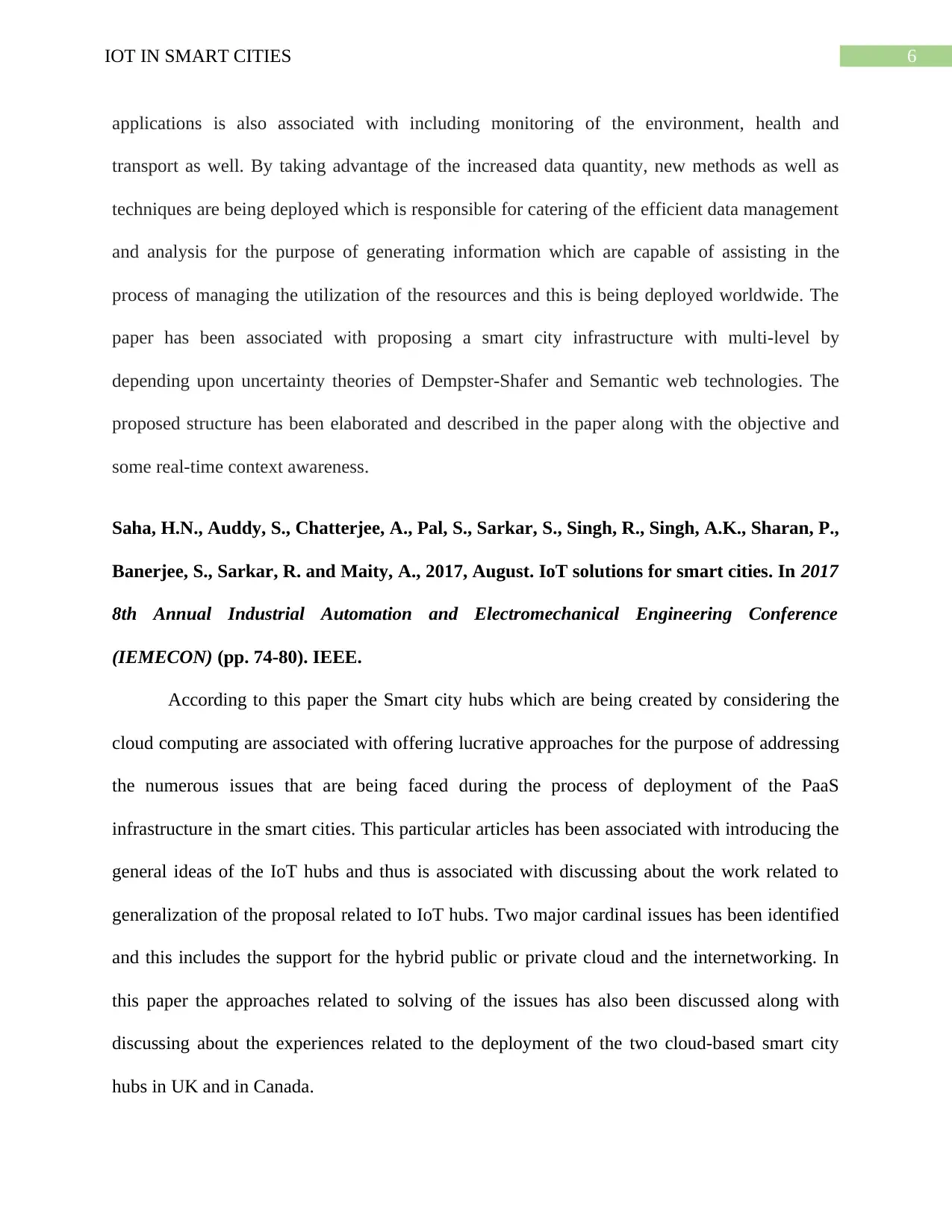
6IOT IN SMART CITIES
applications is also associated with including monitoring of the environment, health and
transport as well. By taking advantage of the increased data quantity, new methods as well as
techniques are being deployed which is responsible for catering of the efficient data management
and analysis for the purpose of generating information which are capable of assisting in the
process of managing the utilization of the resources and this is being deployed worldwide. The
paper has been associated with proposing a smart city infrastructure with multi-level by
depending upon uncertainty theories of Dempster-Shafer and Semantic web technologies. The
proposed structure has been elaborated and described in the paper along with the objective and
some real-time context awareness.
Saha, H.N., Auddy, S., Chatterjee, A., Pal, S., Sarkar, S., Singh, R., Singh, A.K., Sharan, P.,
Banerjee, S., Sarkar, R. and Maity, A., 2017, August. IoT solutions for smart cities. In 2017
8th Annual Industrial Automation and Electromechanical Engineering Conference
(IEMECON) (pp. 74-80). IEEE.
According to this paper the Smart city hubs which are being created by considering the
cloud computing are associated with offering lucrative approaches for the purpose of addressing
the numerous issues that are being faced during the process of deployment of the PaaS
infrastructure in the smart cities. This particular articles has been associated with introducing the
general ideas of the IoT hubs and thus is associated with discussing about the work related to
generalization of the proposal related to IoT hubs. Two major cardinal issues has been identified
and this includes the support for the hybrid public or private cloud and the internetworking. In
this paper the approaches related to solving of the issues has also been discussed along with
discussing about the experiences related to the deployment of the two cloud-based smart city
hubs in UK and in Canada.
applications is also associated with including monitoring of the environment, health and
transport as well. By taking advantage of the increased data quantity, new methods as well as
techniques are being deployed which is responsible for catering of the efficient data management
and analysis for the purpose of generating information which are capable of assisting in the
process of managing the utilization of the resources and this is being deployed worldwide. The
paper has been associated with proposing a smart city infrastructure with multi-level by
depending upon uncertainty theories of Dempster-Shafer and Semantic web technologies. The
proposed structure has been elaborated and described in the paper along with the objective and
some real-time context awareness.
Saha, H.N., Auddy, S., Chatterjee, A., Pal, S., Sarkar, S., Singh, R., Singh, A.K., Sharan, P.,
Banerjee, S., Sarkar, R. and Maity, A., 2017, August. IoT solutions for smart cities. In 2017
8th Annual Industrial Automation and Electromechanical Engineering Conference
(IEMECON) (pp. 74-80). IEEE.
According to this paper the Smart city hubs which are being created by considering the
cloud computing are associated with offering lucrative approaches for the purpose of addressing
the numerous issues that are being faced during the process of deployment of the PaaS
infrastructure in the smart cities. This particular articles has been associated with introducing the
general ideas of the IoT hubs and thus is associated with discussing about the work related to
generalization of the proposal related to IoT hubs. Two major cardinal issues has been identified
and this includes the support for the hybrid public or private cloud and the internetworking. In
this paper the approaches related to solving of the issues has also been discussed along with
discussing about the experiences related to the deployment of the two cloud-based smart city
hubs in UK and in Canada.
Paraphrase This Document
Need a fresh take? Get an instant paraphrase of this document with our AI Paraphraser
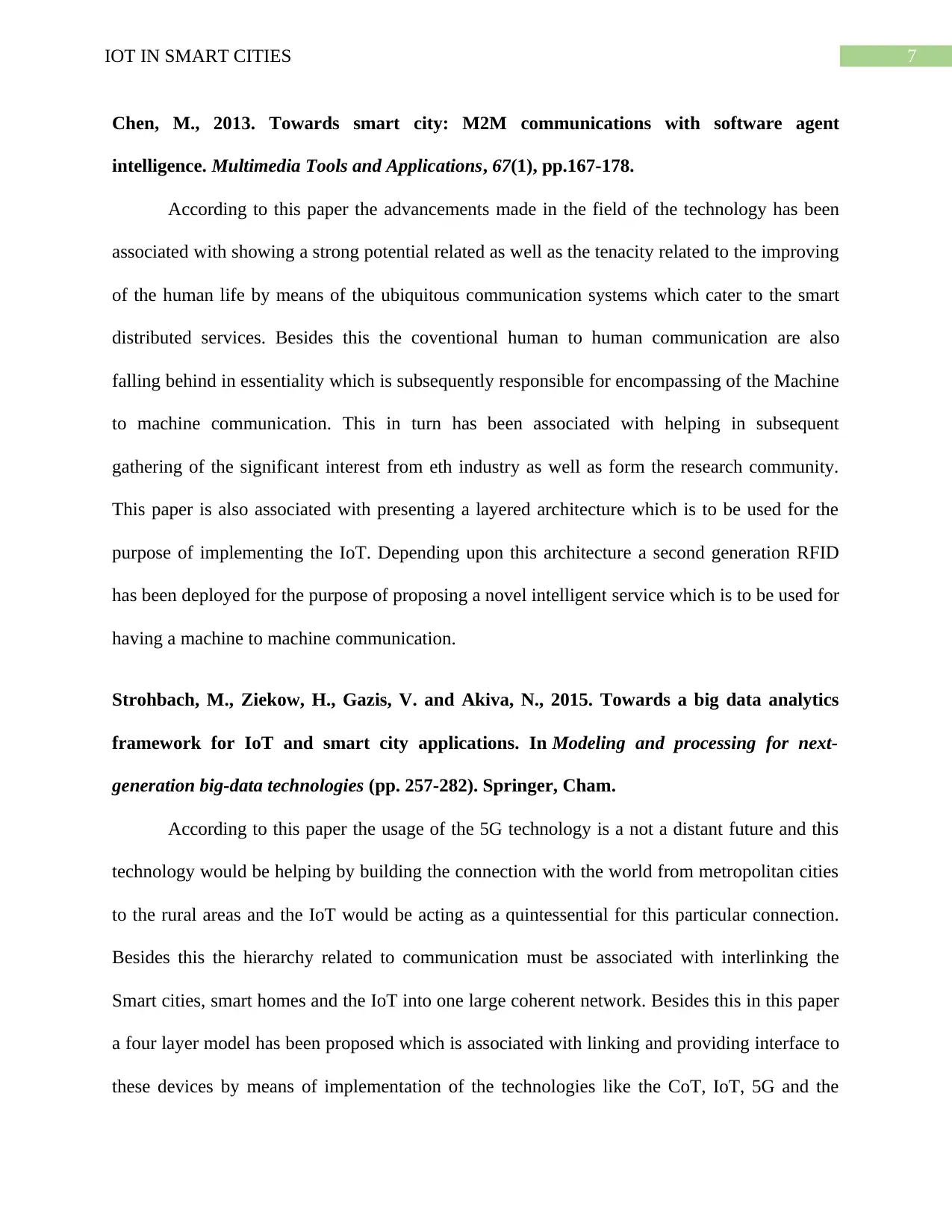
7IOT IN SMART CITIES
Chen, M., 2013. Towards smart city: M2M communications with software agent
intelligence. Multimedia Tools and Applications, 67(1), pp.167-178.
According to this paper the advancements made in the field of the technology has been
associated with showing a strong potential related as well as the tenacity related to the improving
of the human life by means of the ubiquitous communication systems which cater to the smart
distributed services. Besides this the coventional human to human communication are also
falling behind in essentiality which is subsequently responsible for encompassing of the Machine
to machine communication. This in turn has been associated with helping in subsequent
gathering of the significant interest from eth industry as well as form the research community.
This paper is also associated with presenting a layered architecture which is to be used for the
purpose of implementing the IoT. Depending upon this architecture a second generation RFID
has been deployed for the purpose of proposing a novel intelligent service which is to be used for
having a machine to machine communication.
Strohbach, M., Ziekow, H., Gazis, V. and Akiva, N., 2015. Towards a big data analytics
framework for IoT and smart city applications. In Modeling and processing for next-
generation big-data technologies (pp. 257-282). Springer, Cham.
According to this paper the usage of the 5G technology is a not a distant future and this
technology would be helping by building the connection with the world from metropolitan cities
to the rural areas and the IoT would be acting as a quintessential for this particular connection.
Besides this the hierarchy related to communication must be associated with interlinking the
Smart cities, smart homes and the IoT into one large coherent network. Besides this in this paper
a four layer model has been proposed which is associated with linking and providing interface to
these devices by means of implementation of the technologies like the CoT, IoT, 5G and the
Chen, M., 2013. Towards smart city: M2M communications with software agent
intelligence. Multimedia Tools and Applications, 67(1), pp.167-178.
According to this paper the advancements made in the field of the technology has been
associated with showing a strong potential related as well as the tenacity related to the improving
of the human life by means of the ubiquitous communication systems which cater to the smart
distributed services. Besides this the coventional human to human communication are also
falling behind in essentiality which is subsequently responsible for encompassing of the Machine
to machine communication. This in turn has been associated with helping in subsequent
gathering of the significant interest from eth industry as well as form the research community.
This paper is also associated with presenting a layered architecture which is to be used for the
purpose of implementing the IoT. Depending upon this architecture a second generation RFID
has been deployed for the purpose of proposing a novel intelligent service which is to be used for
having a machine to machine communication.
Strohbach, M., Ziekow, H., Gazis, V. and Akiva, N., 2015. Towards a big data analytics
framework for IoT and smart city applications. In Modeling and processing for next-
generation big-data technologies (pp. 257-282). Springer, Cham.
According to this paper the usage of the 5G technology is a not a distant future and this
technology would be helping by building the connection with the world from metropolitan cities
to the rural areas and the IoT would be acting as a quintessential for this particular connection.
Besides this the hierarchy related to communication must be associated with interlinking the
Smart cities, smart homes and the IoT into one large coherent network. Besides this in this paper
a four layer model has been proposed which is associated with linking and providing interface to
these devices by means of implementation of the technologies like the CoT, IoT, 5G and the

8IOT IN SMART CITIES
distributed artificial intelligence. Besides this the benefits and eth services which are offered by
his new structure such as the IoT which are network connected, smart home.
distributed artificial intelligence. Besides this the benefits and eth services which are offered by
his new structure such as the IoT which are network connected, smart home.
⊘ This is a preview!⊘
Do you want full access?
Subscribe today to unlock all pages.

Trusted by 1+ million students worldwide
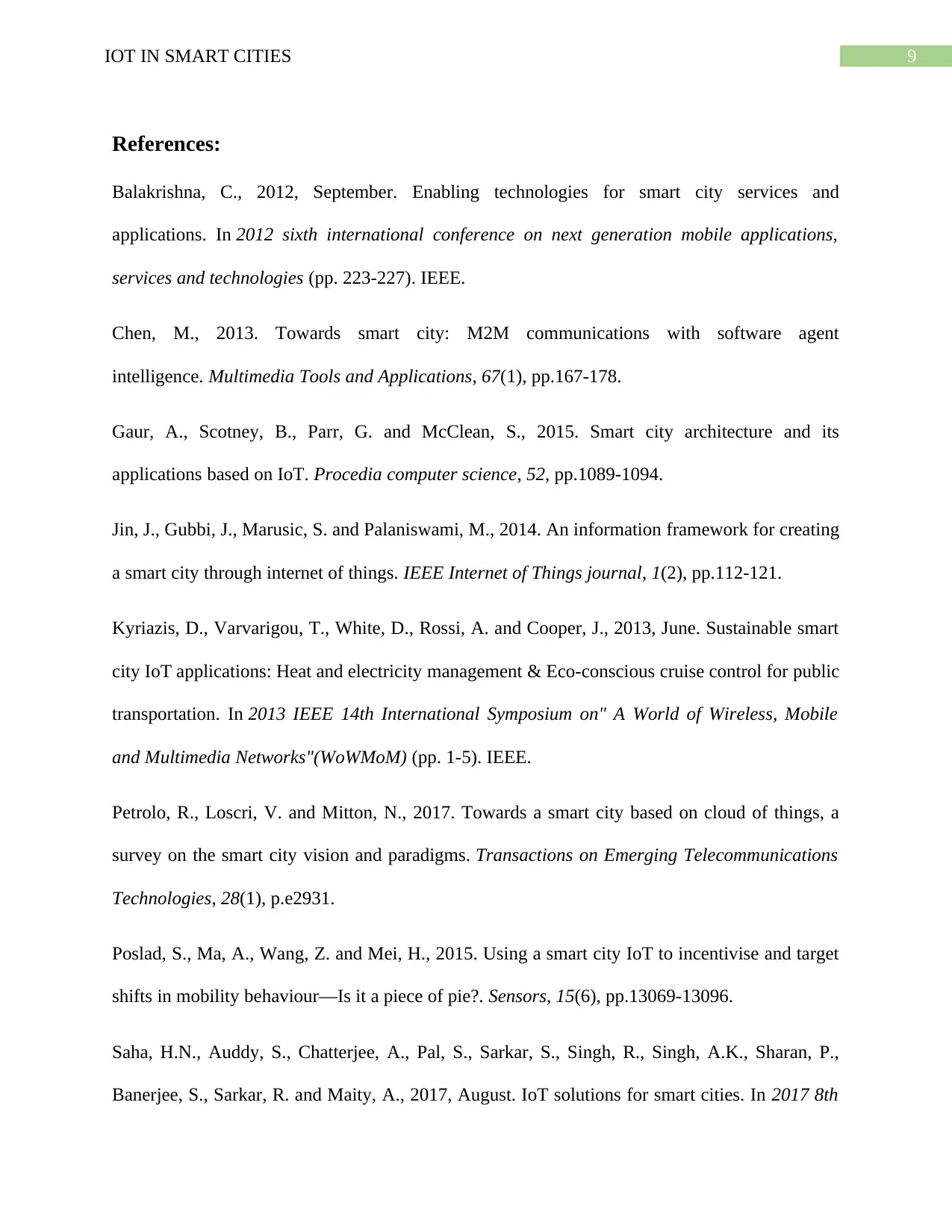
9IOT IN SMART CITIES
References:
Balakrishna, C., 2012, September. Enabling technologies for smart city services and
applications. In 2012 sixth international conference on next generation mobile applications,
services and technologies (pp. 223-227). IEEE.
Chen, M., 2013. Towards smart city: M2M communications with software agent
intelligence. Multimedia Tools and Applications, 67(1), pp.167-178.
Gaur, A., Scotney, B., Parr, G. and McClean, S., 2015. Smart city architecture and its
applications based on IoT. Procedia computer science, 52, pp.1089-1094.
Jin, J., Gubbi, J., Marusic, S. and Palaniswami, M., 2014. An information framework for creating
a smart city through internet of things. IEEE Internet of Things journal, 1(2), pp.112-121.
Kyriazis, D., Varvarigou, T., White, D., Rossi, A. and Cooper, J., 2013, June. Sustainable smart
city IoT applications: Heat and electricity management & Eco-conscious cruise control for public
transportation. In 2013 IEEE 14th International Symposium on" A World of Wireless, Mobile
and Multimedia Networks"(WoWMoM) (pp. 1-5). IEEE.
Petrolo, R., Loscri, V. and Mitton, N., 2017. Towards a smart city based on cloud of things, a
survey on the smart city vision and paradigms. Transactions on Emerging Telecommunications
Technologies, 28(1), p.e2931.
Poslad, S., Ma, A., Wang, Z. and Mei, H., 2015. Using a smart city IoT to incentivise and target
shifts in mobility behaviour—Is it a piece of pie?. Sensors, 15(6), pp.13069-13096.
Saha, H.N., Auddy, S., Chatterjee, A., Pal, S., Sarkar, S., Singh, R., Singh, A.K., Sharan, P.,
Banerjee, S., Sarkar, R. and Maity, A., 2017, August. IoT solutions for smart cities. In 2017 8th
References:
Balakrishna, C., 2012, September. Enabling technologies for smart city services and
applications. In 2012 sixth international conference on next generation mobile applications,
services and technologies (pp. 223-227). IEEE.
Chen, M., 2013. Towards smart city: M2M communications with software agent
intelligence. Multimedia Tools and Applications, 67(1), pp.167-178.
Gaur, A., Scotney, B., Parr, G. and McClean, S., 2015. Smart city architecture and its
applications based on IoT. Procedia computer science, 52, pp.1089-1094.
Jin, J., Gubbi, J., Marusic, S. and Palaniswami, M., 2014. An information framework for creating
a smart city through internet of things. IEEE Internet of Things journal, 1(2), pp.112-121.
Kyriazis, D., Varvarigou, T., White, D., Rossi, A. and Cooper, J., 2013, June. Sustainable smart
city IoT applications: Heat and electricity management & Eco-conscious cruise control for public
transportation. In 2013 IEEE 14th International Symposium on" A World of Wireless, Mobile
and Multimedia Networks"(WoWMoM) (pp. 1-5). IEEE.
Petrolo, R., Loscri, V. and Mitton, N., 2017. Towards a smart city based on cloud of things, a
survey on the smart city vision and paradigms. Transactions on Emerging Telecommunications
Technologies, 28(1), p.e2931.
Poslad, S., Ma, A., Wang, Z. and Mei, H., 2015. Using a smart city IoT to incentivise and target
shifts in mobility behaviour—Is it a piece of pie?. Sensors, 15(6), pp.13069-13096.
Saha, H.N., Auddy, S., Chatterjee, A., Pal, S., Sarkar, S., Singh, R., Singh, A.K., Sharan, P.,
Banerjee, S., Sarkar, R. and Maity, A., 2017, August. IoT solutions for smart cities. In 2017 8th
Paraphrase This Document
Need a fresh take? Get an instant paraphrase of this document with our AI Paraphraser

10IOT IN SMART CITIES
Annual Industrial Automation and Electromechanical Engineering Conference (IEMECON) (pp.
74-80). IEEE.
Strohbach, M., Ziekow, H., Gazis, V. and Akiva, N., 2015. Towards a big data analytics
framework for IoT and smart city applications. In Modeling and processing for next-generation
big-data technologies (pp. 257-282). Springer, Cham.
Theodoridis, E., Mylonas, G. and Chatzigiannakis, I., 2013, July. Developing an iot smart city
framework. In IISA 2013 (pp. 1-6). IEEE.
Annual Industrial Automation and Electromechanical Engineering Conference (IEMECON) (pp.
74-80). IEEE.
Strohbach, M., Ziekow, H., Gazis, V. and Akiva, N., 2015. Towards a big data analytics
framework for IoT and smart city applications. In Modeling and processing for next-generation
big-data technologies (pp. 257-282). Springer, Cham.
Theodoridis, E., Mylonas, G. and Chatzigiannakis, I., 2013, July. Developing an iot smart city
framework. In IISA 2013 (pp. 1-6). IEEE.
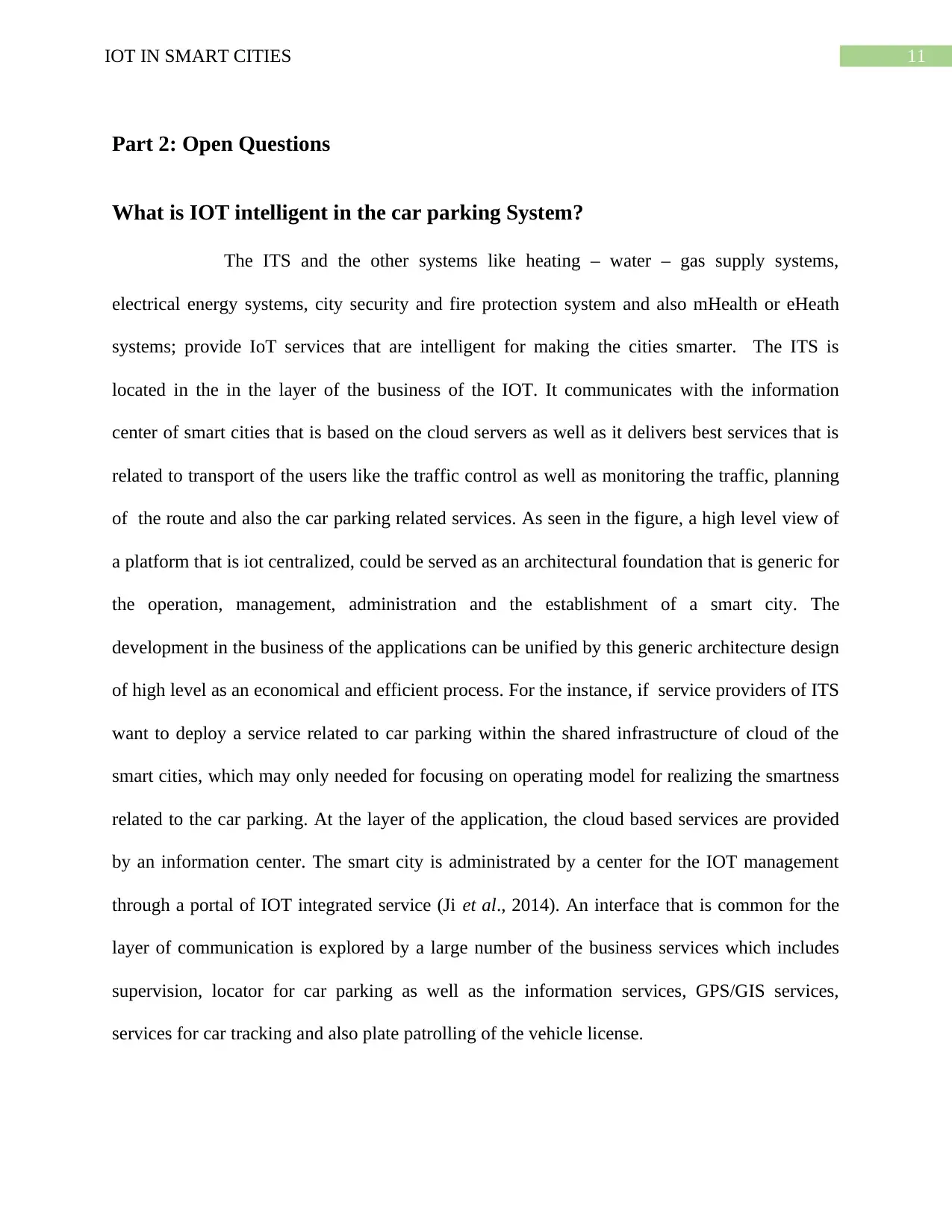
11IOT IN SMART CITIES
Part 2: Open Questions
What is IOT intelligent in the car parking System?
The ITS and the other systems like heating – water – gas supply systems,
electrical energy systems, city security and fire protection system and also mHealth or eHeath
systems; provide IoT services that are intelligent for making the cities smarter. The ITS is
located in the in the layer of the business of the IOT. It communicates with the information
center of smart cities that is based on the cloud servers as well as it delivers best services that is
related to transport of the users like the traffic control as well as monitoring the traffic, planning
of the route and also the car parking related services. As seen in the figure, a high level view of
a platform that is iot centralized, could be served as an architectural foundation that is generic for
the operation, management, administration and the establishment of a smart city. The
development in the business of the applications can be unified by this generic architecture design
of high level as an economical and efficient process. For the instance, if service providers of ITS
want to deploy a service related to car parking within the shared infrastructure of cloud of the
smart cities, which may only needed for focusing on operating model for realizing the smartness
related to the car parking. At the layer of the application, the cloud based services are provided
by an information center. The smart city is administrated by a center for the IOT management
through a portal of IOT integrated service (Ji et al., 2014). An interface that is common for the
layer of communication is explored by a large number of the business services which includes
supervision, locator for car parking as well as the information services, GPS/GIS services,
services for car tracking and also plate patrolling of the vehicle license.
Part 2: Open Questions
What is IOT intelligent in the car parking System?
The ITS and the other systems like heating – water – gas supply systems,
electrical energy systems, city security and fire protection system and also mHealth or eHeath
systems; provide IoT services that are intelligent for making the cities smarter. The ITS is
located in the in the layer of the business of the IOT. It communicates with the information
center of smart cities that is based on the cloud servers as well as it delivers best services that is
related to transport of the users like the traffic control as well as monitoring the traffic, planning
of the route and also the car parking related services. As seen in the figure, a high level view of
a platform that is iot centralized, could be served as an architectural foundation that is generic for
the operation, management, administration and the establishment of a smart city. The
development in the business of the applications can be unified by this generic architecture design
of high level as an economical and efficient process. For the instance, if service providers of ITS
want to deploy a service related to car parking within the shared infrastructure of cloud of the
smart cities, which may only needed for focusing on operating model for realizing the smartness
related to the car parking. At the layer of the application, the cloud based services are provided
by an information center. The smart city is administrated by a center for the IOT management
through a portal of IOT integrated service (Ji et al., 2014). An interface that is common for the
layer of communication is explored by a large number of the business services which includes
supervision, locator for car parking as well as the information services, GPS/GIS services,
services for car tracking and also plate patrolling of the vehicle license.
⊘ This is a preview!⊘
Do you want full access?
Subscribe today to unlock all pages.

Trusted by 1+ million students worldwide
1 out of 18
Related Documents
Your All-in-One AI-Powered Toolkit for Academic Success.
+13062052269
info@desklib.com
Available 24*7 on WhatsApp / Email
![[object Object]](/_next/static/media/star-bottom.7253800d.svg)
Unlock your academic potential
Copyright © 2020–2025 A2Z Services. All Rights Reserved. Developed and managed by ZUCOL.





